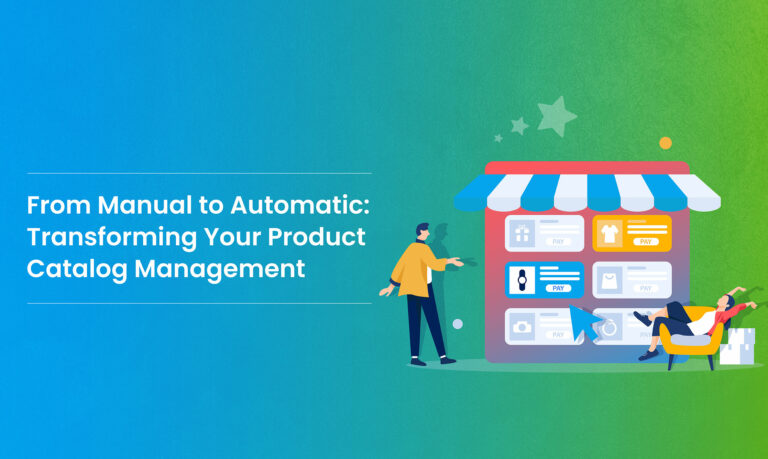Introduction
Catalogs are orderly lists of information about items, services, or library collections. They could be physical or digital. Catalog automation is a software-based process that streamlines catalog production, administration, and delivery. This minimizes errors by retrieving data from a centralized database, assuring correctness and consistency.
Automation improves productivity by automating repetitive operations, freeing up staff time for other purposes. It also enables speedier revisions to pricing, inventory, and product descriptions, which is useful for firms with regular stock changes or promotions.
Finally, catalog automation improves the consumer experience by offering up-to-date and accurate product information.
Why Catalog Automation > Manual Automation?
A well-maintained product catalog is essential for success in today’s corporate environment. It functions as a shop window for online merchants, a resource for wholesalers, and a tool for internal procedures.
However, keeping a big catalog can be time-consuming and error-prone due to human data entry, product classification, and picture management. Catalog automation helps to expedite procedures, improve accuracy, and free up important resources.
Why is Catalog Error Reduction important in today’s business environment?
Businesses need to eliminate catalog errors because they:
- improve customer experience,
- boost search functionality,
- cut down on returns,
- boost productivity and efficiency,
- simplify operations,
- improve data quality,
- boost brand reputation, and
- provide a competitive edge.
Precise data in product catalogs increases customer pleasure, fosters confidence, and improves search capabilities. Additionally, catalog automation frees up employee time that may be used for customer care or product development. Businesses may survive and grow in the current dynamic industry by investing in catalog automation and getting rid of errors.
What are the potential causes of errors in manual cataloging?
Manual cataloging has a very high rate of inaccuracies. Let’s take a closer look at some typical reasons:
- Manual data entry is prone to errors, such as typos, formatting difficulties, and incorrect product classification.
- Data inconsistency arises when information is entered incorrectly across several platforms or departments, confusing internal and external users.
- It can also result in obsolete information, which can mislead customers and lower sales.
- More product descriptions or specifications may also leave clients with unanswered questions, lowering trust in the purchase.
How does catalog automation help to reduce these errors?
Catalog automation uses technology to automate repetitive operations involved with catalog administration, considerably reducing the likelihood of errors. Here’s how:
- Automation software may collect product data from various sources, minimizing human error during manual typing.
- It can also utilize algorithms to automatically assign product qualities to categories while ensuring consistency and searchability.
- Automation solutions can check data accuracy and highlight errors by adding missing information from reliable sources.
- Furthermore, automation may manage photographs by resizing, optimizing, and watermarking them according to specified requirements, maintaining uniform quality throughout the collection and avoiding the need for manual changes.
Step-by-step breakdown of how Catalog Error Reduction works
Catalog automation is an effective alternative to the time-consuming and error-prone process of catalog production, particularly for firms with big product lines.
- It involves a centralized data source, such as a Product Information Management (PIM) system, which serves as the primary data source for all product data.
- This information is then automatically entered into catalog templates, minimizing the need for manual data entry and reducing errors.
- Template design and customization are also important for maintaining brand consistency between catalogs.
- Data automation rules are configured to manage dynamic content, such as pricing adjustments based on promotions or identifying low-stock items.
- The software then automates catalog creation and dissemination in a variety of formats, including print, PDF, and digital versions for websites, to ensure smooth delivery.
Selecting the right tool
Your budget and unique goals will define the best tool for your company. When selecting a technology for catalog automation, take into account the following aspects:
- Catalog Size and Complexity
A comprehensive PIM solution like InRiver or Akeneo can be the ideal choice for your business if it has a large or complex catalog.
- Features Required
Think about the specific features you require, like content creation, product classification, data extraction, and system integration.
- Budget
It’s important to consider features and expenses before purchasing because different items have different pricing strategies.
- Scalability
Choose a tool that will help you achieve your long-term growth goals.
Best Tools for Catalog Automation
- Rubick.ai: Leading the way in catalog automation, Rubick.ai enhances catalog administration with state-of-the-art AI technology. Many features are available on their platform, such as intelligent product classification, price intelligence tools, content creation and optimization, automated data extraction and enrichment, and more.
- Plytix: A cloud-based PIM platform created specifically for online retailers. It improves product listings, streamlines the management of product data, and raises SEO exposure.
- Akeneo: Product data governance and workflow automation are the main objectives of this well-known PIM solution. For a consistent customer experience, it has features like multichannel publishing, product enrichment, and data import/export capabilities.
- InRiver: An integrated product information management (PIM) system is provided by the InRiver platform. InRiver offers connectors with numerous e-commerce systems, workflow management features, and tools for standardizing and cleaning data.
- Daisy from CommerceTools: Along with omnichannel commerce, product lifecycle management, and data management features, this cloud-native PIM platform also offers product enrichment.
Benefits of Catalog Automation in Error Reduction
Catalog automation has various advantages, including reduced errors, enhanced productivity, shorter time to market, better customer experience, and lower costs.
- It eliminates manual data entry errors, resulting in accurate and consistent catalogs.
- It also enables faster product launches and promotions, which improves the customer experience. Automation also saves time and resources over human catalog production.
- Aside from efficiency, automation offers strategic benefits such as higher data quality, more tailored customer experiences, and improved multichannel selling.
- Accurate and consistent product data enables better reporting and analytics, trend identification, product offering optimization, and marketing campaign improvement.
Overall, catalog automation offers a substantial advantage to organizations of all sizes by automating the process, minimizing errors, and promoting faster and less expensive catalog generation.
Conclusion
Catalog automation is becoming increasingly important for firms to keep a competitive edge. Businesses may improve accuracy and productivity and gain important insights from their product data by automating repetitive operations and utilizing artificial intelligence.
A reduced catalog can free up resources, improve the client experience, and lay the groundwork for future expansion. Employees can work more efficiently by focusing on strategic initiatives and leaving catalog automation to tools like Rubick.ai. A reduced catalog can also improve marketing efforts and provide important insights based on product data, hence fueling future growth. Investing in catalog automation is an investment in your company’s future, providing a competitive advantage in an ever-changing market scenario.


